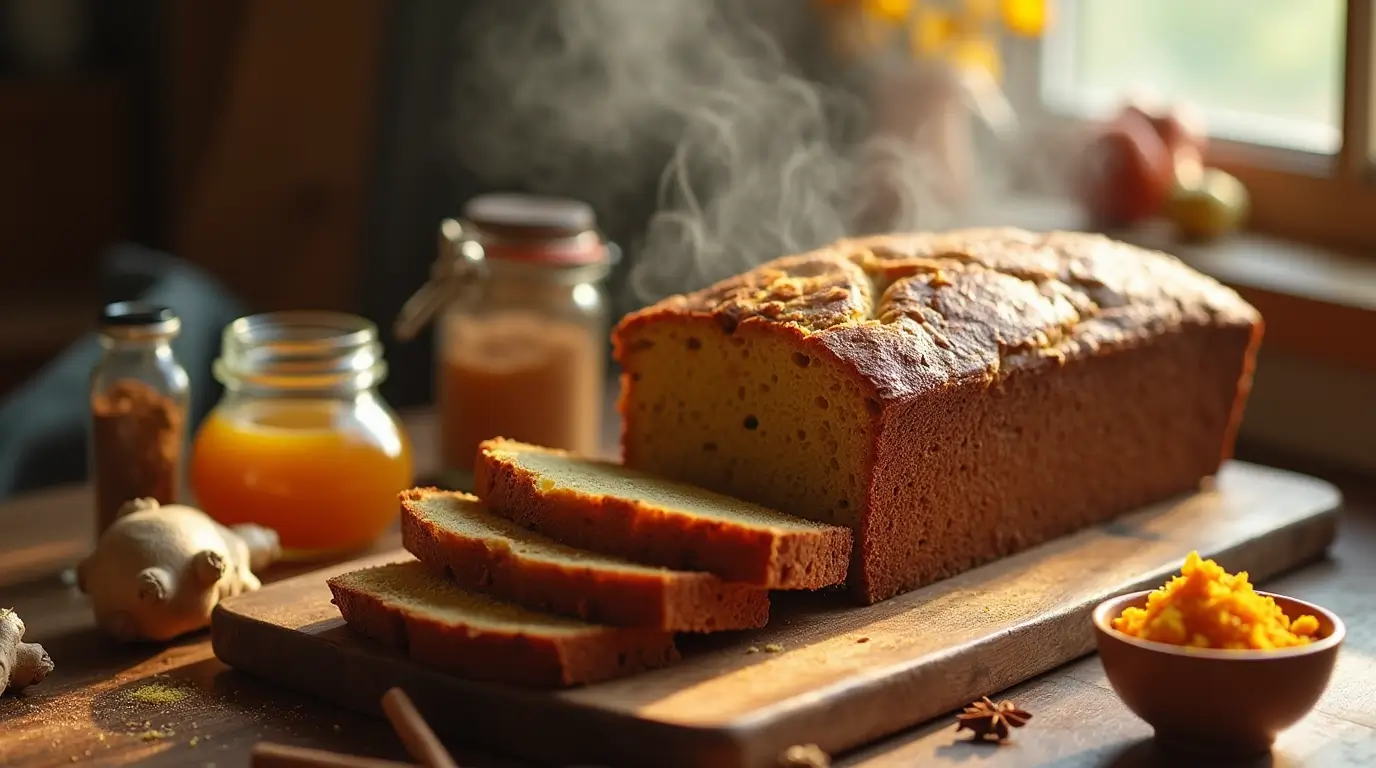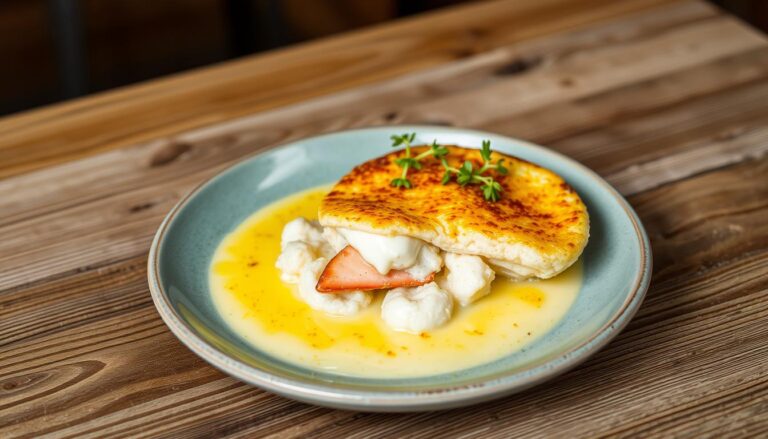How to Enhance Bread Recipe Using Ginger: A Step-by-Step Recipe Guide
Table of Contents
Baking bread at home (bread recipe using ginger) can be one of the most satisfying and rewarding experiences. There’s something magical about pulling a fresh loaf from the oven, its warm aroma filling your kitchen. But what if you could take that basic loaf and elevate it with the warming, aromatic spice of ginger? Adding ginger to your bread is a simple yet transformative step that brings a whole new level of flavor, complexity, and even health benefits. In this guide, we’ll show you how to enhance your bread with ginger, from choosing the right type of ginger to perfecting your dough. Let’s dive into this aromatic and flavorful adventure!
Why Use Ginger in Bread?
You might be wondering: Why add ginger to bread? After all, it’s a spice traditionally used in sweets like gingerbread or as an ingredient in savory dishes like stir-fries. So, why not stick to the basics? The truth is, ginger adds much more than just flavor—it offers a host of benefits that can make your homemade bread even more special.
Health Benefits of Ginger
Ginger isn’t just about its flavor. This spice has long been known for its medicinal properties. Adding ginger to your bread not only enhances the taste but can also help boost your health. Some key benefits include:
- Anti-inflammatory properties: Ginger is packed with compounds that help reduce inflammation, making it a great addition for those with joint pain or digestive issues.
- Improved digestion: Ginger stimulates saliva, bile, and gastric enzymes, which can help in the digestive process. It’s also commonly used to alleviate nausea.
- Boosts immunity: Thanks to its antioxidant properties, ginger can help strengthen the immune system, making it a perfect addition to your bread during colder months.
Flavor Enhancements
When it comes to flavor, ginger is incredibly versatile. The spice has a unique combination of heat, sweetness, and a touch of citrus. These flavor notes add complexity and richness to your bread, making each bite more interesting. Whether you prefer a subtle kick or a more intense ginger punch, it’s easy to adjust the amount you use.
- Warmth in every bite: The slightly spicy and warming quality of ginger enhances the depth of flavor, transforming an ordinary loaf into something extraordinary.
- Pairs well with other spices: Ginger complements other spices, such as cinnamon, cloves, and nutmeg, making it a perfect addition for fall-inspired breads. It also goes wonderfully with sweeter ingredients like honey or brown sugar.
The Aromatic Experience
Ginger isn’t just for the taste buds—it also offers an unforgettable sensory experience. The scent of ginger as it bakes in the oven adds an extra layer of comfort, creating an inviting atmosphere in your home. It’s like wrapping yourself in a cozy blanket of warmth.
Types of Ginger to Use in Your Bread Recipe
Before you get started, it’s essential to know that there are several types of ginger you can use in your bread. Each type brings something unique to the table, so let’s break them down and see how you can use each one to enhance your loaf.
Fresh Ginger Root
Fresh ginger root is the most common form of ginger you’ll encounter. It has a pungent, zesty flavor that can add a fresh kick to your bread. When used in baking, it infuses the dough with an unmistakable, bold ginger taste.
How to use:
- Peel and finely grate or mince the ginger to ensure an even distribution throughout the dough. The finer the ginger, the better it will incorporate into your bread.
- Fresh ginger works best in recipes where you want that zesty, spicy punch—such as in a hearty, savory loaf or in a slightly spicy sweet bread.
Ground Ginger
Ground ginger is a more concentrated version of ginger and is perfect for when you want a consistent, evenly distributed flavor in your bread. It’s also incredibly convenient and easy to use.
How to use:
- Use ground ginger in your dry ingredients. For a standard loaf, around 1-2 teaspoons will provide a gentle ginger flavor without overpowering the bread.
- Ground ginger pairs particularly well with other spices like cinnamon or nutmeg, making it ideal for autumn-inspired bread recipes.
Candied Ginger
Candied ginger is fresh ginger that’s been simmered in sugar syrup and coated in sugar crystals. It offers a unique combination of sweet and spicy flavors, along with a chewy texture that’s perfect for adding a fun twist to your bread.
How to use:
- Chop candied ginger into small pieces and fold them into your dough after it has been mixed. The chewy bits provide delightful bursts of sweetness and spice in every bite.
- Candied ginger is a great choice for sweeter bread recipes, such as gingerbread or a honey-ginger loaf.
Step-by-Step Guide to Making Ginger-Infused Bread
Now that we’ve covered the types of ginger to use, let’s dive into the step-by-step process of making ginger-infused bread. This section will guide you through each stage, so you can achieve the perfect loaf with a touch of spice.
1. Prepare Your Ingredients
Start by gathering all the necessary ingredients for your ginger bread recipe. Here’s a basic list to get you started:
- Fresh ginger (grated or chopped)
- Ground ginger (optional)
- All-purpose flour
- Active dry yeast
- Salt
- Sugar (white or brown)
- Milk or water
- Butter or oil
The quality of your ingredients plays a significant role in the final outcome, so make sure you use the best possible options for each.
2. Mix the Dough
- In a large mixing bowl, combine the dry ingredients first: flour, salt, yeast, and ground ginger (if using). Stir them together.
- Add the fresh ginger (grated or minced) to the dry mix for that fresh kick.
- In a separate bowl, warm your liquid ingredients (milk or water) and dissolve the sugar in it. The liquid should be just warm enough to activate the yeast—too hot, and it could kill the yeast.
- Gradually add the wet ingredients to the dry ingredients, stirring to combine. If you’re using butter, melt it and add it to the mix at this stage.
3. Knead the Dough
Once the dough begins to come together, it’s time to knead. Turn the dough onto a clean, floured surface and knead for about 8-10 minutes until it becomes smooth and elastic.
Pro tip: If the dough feels too sticky, add a little more flour. If it’s too dry, add a teaspoon of water at a time until it’s just right.
4. Let the Dough Rise
Place your kneaded dough in a lightly oiled bowl and cover it with a clean kitchen towel. Allow the dough to rise in a warm place for about 1–2 hours, or until it has doubled in size. This process is essential for achieving a light and airy texture.
5. Shape and Bake
Once the dough has risen, punch it down to release the air bubbles. Shape it into a loaf or divide it into rolls, depending on your preference. Place the dough onto a greased baking pan or a baking sheet.
Let the dough rise again for about 30 minutes before baking. Preheat your oven to 375°F (190°C) and bake for 30-35 minutes, or until the loaf sounds hollow when tapped on the bottom. The top should be golden brown.
Key Ingredients for the Perfect Ginger Bread
Here’s a closer look at the key ingredients you’ll need for your ginger bread, along with some tips on how to get the best results:
| Ingredient | Purpose | Tips for Use |
|---|---|---|
| Fresh Ginger | Adds a fresh, aromatic spiciness | Grate finely to release maximum flavor |
| Ground Ginger | Enhances the dough with concentrated ginger flavor | Use sparingly; a little goes a long way |
| All-purpose Flour | The base of your bread dough | Choose high-quality flour for the best texture |
| Yeast | Provides the lift and rise of the bread | Ensure the yeast is fresh for best results |
| Butter or Oil | Adds richness and moisture to the bread | Use butter for a richer taste, oil for lighter texture |
Troubleshooting Common Issues When Adding Ginger
While adding ginger to bread can be a wonderful experience, there are a few common issues you might run into. Let’s troubleshoot those:
Overpowering Ginger Flavor
If the ginger flavor is too strong, it can easily overwhelm the bread. To avoid this, start with a smaller amount of ginger, and gradually increase it to your liking. Remember, fresh ginger has a stronger flavor than ground ginger, so use it sparingly.
Bread Not Rising Properly
If your bread isn’t rising as expected, there may be an issue with the yeast. Ensure your yeast is fresh and hasn’t expired. Also, make sure you’re letting the dough rise in a warm, draft-free environment. If your kitchen is too cold, consider placing the dough in a slightly heated oven or near a warm stove.
Texture Issues
Sometimes, adding too much ginger can affect the texture of the bread. Stick to the recommended amounts of ginger, especially if you’re using fresh ginger, which contains more moisture. Also, ensure you’re kneading the dough properly to develop the gluten structure for the best texture.
Creative Variations to Try with Ginger Bread
Once you’ve mastered the basics, it’s time to get creative. Here are some fun and unique variations you can try to take your ginger bread to the next level:
Honey and Ginger Bread
For a sweeter twist, add honey to your dough along with the ginger. The honey adds moisture and a natural sweetness that perfectly complements the warmth of the ginger.
Ginger and Cinnamon Bread
Pair ginger with cinnamon for a spiced loaf that’s perfect for the fall and winter months. The combination of these two spices is both comforting and inviting.
Savory Ginger Bread
For something savory, add ginger to a dough mixed with garlic, rosemary, and olive oil. This savory ginger bread can be served alongside soups or stews.
Frequently Asked Questions (FAQ)
Can I use ground ginger instead of fresh ginger for the recipe?
Yes, ground ginger is a great substitute for fresh ginger. Just keep in mind that ground ginger is more concentrated, so use about half the amount you would of fresh ginger.
Can I make ginger bread gluten-free?
Yes! You can easily make ginger bread gluten-free by substituting all-purpose flour with a gluten-free flour blend. Just be sure to add a bit more liquid to the dough, as gluten-free flours tend to absorb more moisture.
What other spices can I pair with ginger in my bread recipe?
In addition to cinnamon and cloves, you can experiment with nutmeg, allspice, or even a bit of cardamom. These spices complement ginger beautifully and enhance the flavor profile of your bread.
Conclusion
Baking ginger-infused bread is an exciting way to enhance your homemade loaves with flavor and warmth. Whether you’re baking for health benefits, flavor, or just the love of baking, ginger can transform your bread into something extraordinary. Now that you have all the tools and tips, it’s time to roll up your sleeves, add some ginger to your dough, and start baking! So, what are you waiting for? Your ginger-infused bread is just a few steps away from being the star of your kitchen.







